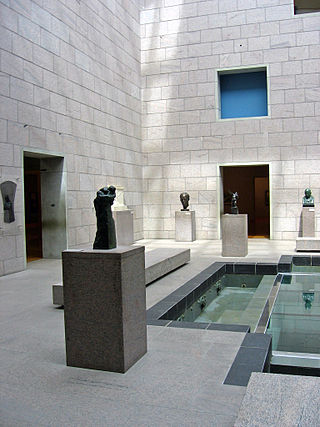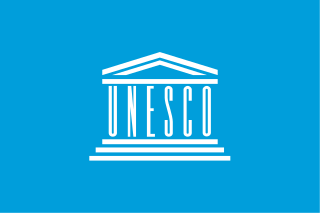

Cultural governance is governance of culture. It includes cultural policy made by governments but extends also to cultural influence exerted by non-state actors and to policies which influence culture indirectly. [3]


Cultural governance is governance of culture. It includes cultural policy made by governments but extends also to cultural influence exerted by non-state actors and to policies which influence culture indirectly. [3]
The tendency to discuss cultural governance rather than policy corresponds to the broader shift from government to governance, with the emphasis shifting from state policymakers to include the influence of civil society organizations and the private sector. A broad interpretation of "governance" could also include government policies outside the scope of cultural policy which nevertheless impact culture. [4] Cultural diversity is a very broad term and encompasses many different aspects from the visible to the invisible aspects.
The precise meaning of "cultural governance" also depends heavily on the definition of culture, which can range from narrow reference to institutions like museums and concert halls connected with the arts to broad meanings such as a society's way of life or its systems of knowledge and symbols. [5] In the broader view, cultural governance deals holistically with the production of meaning in a society, through aspects including the culture industry, the formation of taste, and the use of language. [6]
The dominant actor in global cultural governance is UNESCO, a United Nations specialized agency created in 1946 and headquartered in Paris, France. [7] UNESCO produces documents which local governments frequently use as guidelines and may incorporate into law. It has also promoted the development of networks such as the Global Alliance for Cultural Diversity to promote public/social/private partnership in the cultural area. In recent years[ when? ] the organization has emphasized the importance of cities (with non-profit organizations participating in local governance) as cultural actors with networks such as the International Coalition of Cities Against Racism and the Creative Cities Network. [7]

UNESCO itself relies upon partnerships with the private sector in selecting, developing, and promoting World Heritage Sites. [7] Meetings for the selection of these sites attract several hundred attendees, including representatives of interested groups. "World heritage" issues gain prominence through promotion in the mass media with publications such as National Geographic and many others. All steps of the process promote the development of a metaculture capable of adjudicating global cultural issues and producing a global literary canon from a vantage point of universality. [6] [8]
Agenda 21 for culture, administered by an international organization called United Cities and Local Governments, represents a vector for global governance conducted by its members at a local level. [7] This concept endorses "culture as a fourth pillar of sustainable development", adding to the three pillars of sustainable development identified in Agenda 21: economy, society, and environment. [7]

Cultural governance in the European Union includes a range of cultural policies geared toward promoting European culture.[ citation needed ]
The European Commission's 2007 communication "on a European agenda for culture in a globalizing world" describes interaction with culture through a various channels, including support for and consultation with cultural organizations, encouragement of artist mobility and intercultural communication, use of European culture in international relations, maintenance of EU copyright law, and promotion of European cultural goods and services. [10] [11] The European governments consider it necessary to promote and guide cultural development actively because of deficiencies in cultural outcomes of the free market. Further, intercultural communication and integration are considered intertwined with economic integration. [11]

In the People's Republic of China a major goal of cultural governance is to reinforce the legitimacy of the government. [13] Culture has long played a role in the governance of China, from the harmonious society promoted by Confucianism to the Cultural Revolution and other Chinese Communist Party strategies for transforming traditional society into industrialized communism. Present-day Chinese leaders have made significant references in speeches to a continual tradition of Chinese culture and its importance for nationalist and geopolitical purposes. Cultural governance is integrated with propaganda, censorship, music, and education. [13] Within the Chinese Ministry of Culture, the State Administration of Cultural Heritage has stated that China's cultural heritage should be used to "strengthen national unity and promote sustainable development of the natural culture". [14]
Localities in China have assumed much of the responsibility for identifying heritage sites, with the result that 300,000 such sites have been declared, many without state protection and support. Local governments have frequently turned to private companies to manage these sites and operate tourism businesses. [14] [2] Sites may also come under many overlapping authorities, as in the case of Mount Wutai, a national park and World Heritage Site, which is managed by eight government agencies and governed by 29 international, national, and local laws. [15]
| Part of a series on |
| Governance |
|---|

Tourism is travel for pleasure, and the commercial activity of providing and supporting such travel. UN Tourism defines tourism more generally, in terms which go "beyond the common perception of tourism as being limited to holiday activity only", as people "travelling to and staying in places outside their usual environment for not more than one consecutive year for leisure and not less than 24 hours, business and other purposes". Tourism can be domestic or international, and international tourism has both incoming and outgoing implications on a country's balance of payments.

A World Heritage Site is a landmark or area with legal protection by an international convention administered by UNESCO. World Heritage Sites are designated by UNESCO for having cultural, historical, scientific or other forms of significance. The sites are judged to contain "cultural and natural heritage around the world considered to be of outstanding value to humanity".

Globalization, or globalisation, is the process of interaction and integration among people, companies, and governments worldwide. The term globalization first appeared in the early 20th century, developed its current meaning sometime in the second half of the 20th century, and came into popular use in the 1990s to describe the unprecedented international connectivity of the post-Cold War world. Its origins can be traced back to 18th and 19th centuries due to advances in transportation and communications technology. This increase in global interactions has caused a growth in international trade and the exchange of ideas, beliefs, and culture. Globalization is primarily an economic process of interaction and integration that is associated with social and cultural aspects. However, disputes and international diplomacy are also large parts of the history of globalization, and of modern globalization.
In the broadest sense, cultural resource management (CRM) is the vocation and practice of managing heritage assets, and other cultural resources such as contemporary art. It incorporates Cultural Heritage Management which is concerned with traditional and historic culture. It also delves into the material culture of archaeology. Cultural resource management encompasses current culture, including progressive and innovative culture, such as urban culture, rather than simply preserving and presenting traditional forms of culture.

Cultural diversity is the quality of diverse or different cultures, as opposed to monoculture. It has a variety of meanings in different contexts, sometimes applying to cultural products like art works in museums or entertainment available online, and sometimes applying to the variety of human cultures or traditions in a specific region, or in the world as a whole. It can also refer to the inclusion of different cultural perspectives in an organization or society.
Good governance is the process of measuring how public institutions conduct public affairs and manage public resources and guarantee the realization of human rights in a manner essentially free of abuse and corruption and with due regard for the rule of law. Governance is "the process of decision-making and the process by which decisions are implemented ". Governance in this context can apply to corporate, international, national, or local governance as well as the interactions between other sectors of society.

International development or global development is a broad concept denoting the idea that societies and countries have differing levels of economic or human development on an international scale. It is the basis for international classifications such as developed country, developing country and least developed country, and for a field of practice and research that in various ways engages with international development processes. There are, however, many schools of thought and conventions regarding which are the exact features constituting the "development" of a country.

Cultural landscape is a term used in the fields of geography, ecology, and heritage studies, to describe a symbiosis of human activity and environment. As defined by the World Heritage Committee, it is the "cultural properties [that] represent the combined works of nature and of man" and falls into three main categories:

A historic site or heritage site is an official location where pieces of political, military, cultural, or social history have been preserved due to their cultural heritage value. Historic sites are usually protected by law, and many have been recognized with official historic status. A historic site may be any building, landscape, site or structure that is of local, regional, national, or global significance. Usually this also means the site must be at least 50 years or older.

Cultural heritage is the heritage of tangible and intangible heritage assets of a group or society that is inherited from past generations. Not all heritages of past generations are "heritage"; rather, heritage is a product of selection by society.

Peacebuilding is an activity that aims to resolve injustice in nonviolent ways and to transform the cultural and structural conditions that generate deadly or destructive conflict. It revolves around developing constructive personal, group, and political relationships across ethnic, religious, class, national, and racial boundaries. The process includes violence prevention; conflict management, resolution, or transformation; and post-conflict reconciliation or trauma healing before, during, and after any given case of violence.

Europa Nostra is a pan-European Federation for Cultural Heritage, representing citizens' organisations that work on safeguarding Europe's cultural and natural heritage. It is the voice of this movement to relevant international bodies, in particular the European Union, the Council of Europe and UNESCO. It has consultative status with UNESCO and is recognised as an NGO partner.

Cultural policy is the government actions, laws and programs that regulate, protect, encourage and financially support activities related to the arts and creative sectors, such as painting, sculpture, music, dance, literature, and filmmaking, among others and culture, which may involve activities related to language, heritage and diversity. The idea of cultural policy was developed at UNESCO in the 1960s. Generally, this involves governments setting in place processes, legal classifications, regulations, legislation and institutions which promote and facilitate cultural diversity and creative expressions in a range of art forms and creative activities. Cultural policies vary from one country to another, but generally they aim to improve the accessibility of arts and creative activities to citizens and promote the artistic, musical, ethnic, sociolinguistic, literary and other expressions of all people in a country. In some countries, especially since the 1970s, there is an emphasis on supporting the culture of Indigenous peoples and marginalized communities and ensuring that cultural industries are representative of a country's diverse cultural heritage and ethnic and linguistic demographics.

Tourism in Bhutan began in 1974, when the Government of Bhutan, in an effort to raise revenue and to promote Bhutanese unique culture and traditions to the outside world, opened its isolated country to foreigners. In 1974 a total of 287 tourists visited the Kingdom of Bhutan. The number of tourists visiting Bhutan increased to 2,850 in 1992, and rose dramatically to 7,158 in 1999. By the late 1980s tourism contributed over US$2 million in annual revenue.

The United Nations Educational, Scientific and Cultural Organization (UNESCO) is a specialized agency of the United Nations (UN) with the aim of promoting world peace and security through international cooperation in education, arts, sciences and culture. It has 194 member states and 12 associate members, as well as partners in the non-governmental, intergovernmental and private sector. Headquartered in Paris, France, UNESCO has 53 regional field offices and 199 national commissions.

Culture 21, also known as Agenda 21 for culture, is a program for cultural governance developed in 2002–2004 and organized by United Cities and Local Governments.

The Ministry of Culture of Azerbaijan Republic is a governmental agency within the Cabinet of Azerbaijan in charge of regulation of the activities and promotion of Azerbaijani culture. The ministry is headed by Anar Karimov.

The Universal Declaration on Cultural Diversity is a declaration adopted unanimously by the General Conference of the United Nations Educational, Scientific and Cultural Organization (UNESCO) at its thirty-first session on 2 November 2001. It calls on nations and institutions to work together for the preservation of culture in all its forms, and for policies that help to share ideas across cultures and inspire new forms of creativity. It interprets "culture" in a broad sense and connects the preservation of culture to central issues of human rights. It defines a role for UNESCO as a space in which different institutions can develop ideas on cultural diversity, which has been a theme of many of UNESCO's activities in the years since. The primary audience of the declaration includes UNESCO's member states as well as international and non-governmental bodies, but other organisations and individuals have also been inspired by it.
The Canadian Commission for UNESCO (CCUNESCO), administered by the Canada Council for the Arts, is Canada's national commission for UNESCO, actively advancing the organization's mandate to contribute to peace based on the intellectual and moral solidarity of humankind by promoting cooperation among nations.
Cultural policy in Abu Dhabi, a city within the United Arab Emirates, refers to any initiative undertaken by the Emirate government aimed at achieving goals to contribute to or shape culture. Abu Dhabi's government aims to develop a cultural infrastructure that will allow it to establish itself as a reference point for culture on three levels: